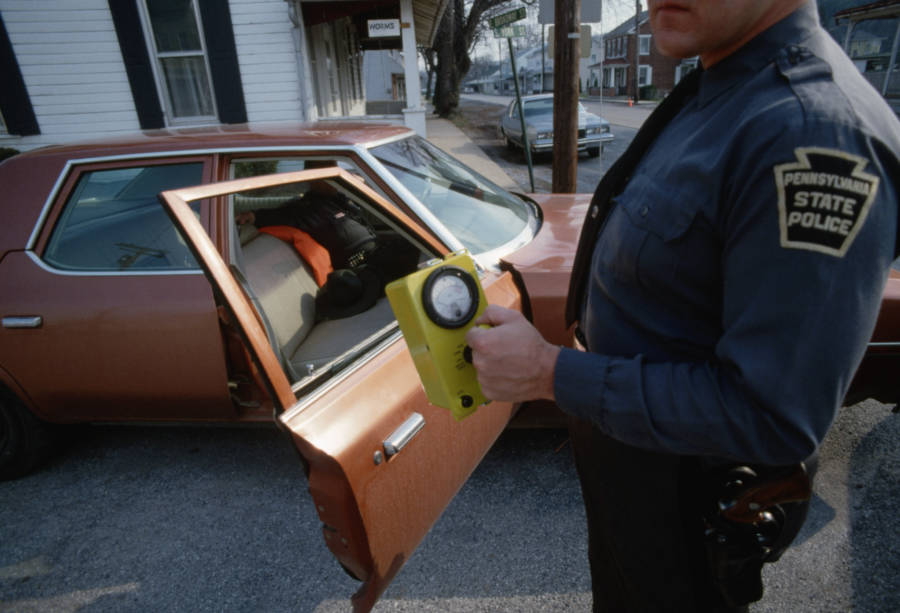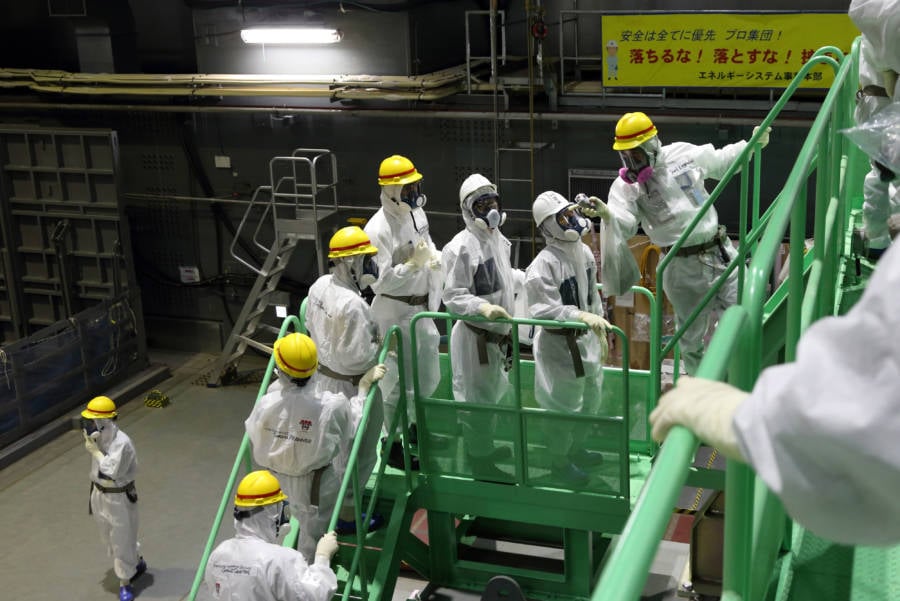Comparable Nuclear Meltdowns
Three Mile Island

Leif Skoogfors/CORBIS/Corbis via Getty ImagesA Pennsylvania State Police officer checking for radioactivity in a town near the Three Mile Island nuclear power plant, 1979.
A few thousand miles and halfway around the world, the United States saw its own nuclear disaster. It was March 28, 1979, when a pressure valve in the Unit-2 reactor at Three Mile Island plant in Pennsylvania failed to close. As a result, radioactive cooling water leaked out and flooded the plant.
Built only five years earlier on the Susquehanna River and becoming operational one year before failure, Three Mile Island was initially praised for its efficient energy production — as the Carter Administration was battling a historical energy crisis at the time.
Once again, human error came into play and caused a fair amount of additional damage. The broken pressure valve kickstarted automatic emergency cooling pumps but confused operators shut the system down. This forced the reactor to a halt — while remaining heat from the fission process continued to escape.
In the end, the core was 1,000 degrees away from reaching a total meltdown. This likely would’ve resulted in a Chernobyl disaster of exposure to radiation.

Wikimedia CommonsCleanup at Three Mile Island, 1979.
Eventually, however, operators assessed the situation and restarted the cooling pumps and reduced the core’s temperature and prevented a complete meltdown — which was less than half an hour away at that point.
Though Pennsylvania Governor Dick Thornburgh came close to evacuating the state and advised “pregnant women and pre-school Agee children to leave until further notice,” and 100,000 people did leave their homes, the crisis came to an end on April 1 of that year. Cleanup, however, took two more decades and finally concluded in 1990.
Fukushima
When an earthquake and subsequent tsunami hit the Fukushima Daiichi Nuclear Power Plant in 2011, it suffered a multiple-reactor meltdown. According to the World Nuclear Association, all three disabled cores melted in the first three days.
Fukushima was rated 7 on the International Nuclear Event Scale, which is about as serious as nuclear accidents can get. It took two weeks to get the three reactors stabilized with 100,000 people evacuating their homes and over 1,000 resulting deaths.
The primary difference between Chernobyl and Fukushima — besides the obvious use of a containment structure here — was that the tsunami that triggered the Japanese meltdown submerged essential safety measure tools such as diesel generators, batteries, electrical switchgear, and cooling systems. These were located in the basements of the turbine buildings.
The tsunami also destroyed necessary infrastructure such as invaluable roads that would’ve allowed for faster access. Of course, a station-wide blackout didn’t help matters.

Nikkei Asian ReviewCrumbling remains of Fukushima’s nuclear plant, 2018.
As in the Chernobyl disaster, iodine-131 and caesium-137 were dispersed into the air but because 23 of the 24 radiation monitoring stations were disabled by the tsunami, tracking the releases proved difficult — to say the least.
While there are still questions as to how substantial the contamination of nuclear materials was, Japan’s Nuclear Regulation Authority found that the most contaminated areas in the plant’s evacuation zone had reduced by three quarters between 2011 and 2013.
In May of 2013, the United Nations Committee on the Effects of Atomic Radiation (UNSCEAR) issued its report, for which 80 international experts contributed their findings and conclusions.
“Radiation exposure following the nuclear accident at Fukushima Daiichi did not cause any immediate health effects,” it said. “It is unlikely to be able to attribute any health effects in the future among the general public and the vast majority of workers.” This does not include the 146 emergency workers that were harshly affected by radiation in the disaster’s early days.

Tomohiro Ohsumi/Bloomberg/Noboru Hashimoto/Corbis via Getty ImagesMembers of the media and Tokyo Electric Power Co. (Tepco) take a tour of the No. 4 reactor at the Fukushima, Nov. 7, 2013.
UNSCEAR’s 2015 follow-up report largely confirmed the panel’s initial findings and stated that none of the new data collected after 2013 “materially affected the main findings in, or challenged the major assumptions of, the 2013 Fukushima report.”
When it comes to Fukushima’s effects on local wildlife, scientists are still studying how substantially regional animal populations have been affected by the reactor’s leaked radiation. Disassembling the crumbling plant’s sarcophagus will take decades and long-term health effects are yet unclear.
There are, however, populations of wild boars roaming around the Fukushima evacuation zone that have been found to contain levels of radioactive elements up to 300 times higher than normal safety standard levels.
The Chernobyl Disaster Lingers In Pripyat And Beyond
In the end, there has never been a nuclear disaster that can compare with Chernobyl’s colossal legacy of fear, paranoia, and generational birth defects. The accident has permeated global culture, influenced post-apocalyptic aesthetic in film and literature, and irradiated entire regions of the planet.
There’s a reason that the name alone triggers immediate awareness and it’s not because the subject is forcibly taught in our schools — it’s because the fallout of the Chernobyl disaster was just as figurative as it was literal and it will likely never be forgotten.
After learning about the Chernobyl disaster and the abandoned ghost town of Pripyat it left in its wake, take a look at 25 photos of the abandoned city of Pripyat. Then, learn about the Soviet-era closed cities built to hide their nuclear program.





